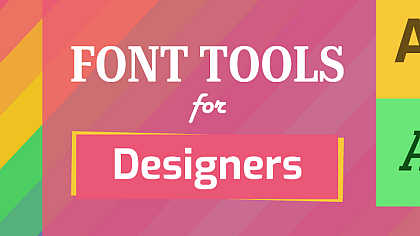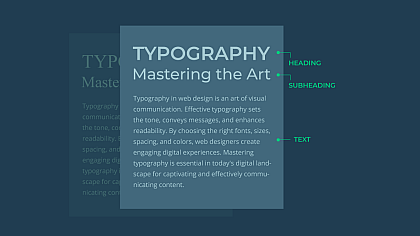
The Psychology of Fonts: How Typography Impacts Perception
Typography is a powerful tool that extends beyond mere aesthetics in design. The choice of fonts can significantly impact the way people perceive and interpret written content.
From advertising campaigns to website designs, understanding the psychology of fonts is essential for effectively conveying messages and influencing the audience.
Delve into the fascinating world of typography and explore how different fonts can evoke specific emotions, influence readability, and shape overall perceptions.
Emotions and Font Styles
Fonts have the ability to evoke emotions and set the tone of a design. Different font styles carry distinct connotations that elicit specific emotional responses. For instance:
Serif Fonts: Fonts with small decorative strokes, known as serifs, are often associated with tradition, formality, and reliability. They convey a sense of sophistication and can be ideal for conveying credibility and trustworthiness.
Sans-Serif Fonts: These fonts are modern, clean, and straightforward. They are often perceived as more casual, approachable, and contemporary. Sans-serif fonts are commonly used for digital platforms and designs targeting younger audiences.
Script Fonts: Mimicking cursive handwriting, script fonts evoke elegance, romance, and creativity. They are suitable for designs that require a touch of sophistication or personalization.
Display Fonts: Display fonts are bold, attention-grabbing, and often unique in design. They can evoke excitement, playfulness, or a sense of uniqueness. However, they should be used sparingly to avoid overwhelming the reader.
Readability and Legibility
The legibility and readability of fonts play a crucial role in effective communication. Legibility refers to how easily individual characters can be distinguished, while readability focuses on the overall ease of reading a block of text. Consider the following factors:
Font Size: Optimal font size ensures readability, especially across various devices and reading distances. Too small, and the text becomes challenging to read, while excessively large fonts may disrupt the natural flow of reading.
Letter Spacing (Kerning) and Line Height (Leading): Proper spacing between letters and lines enhances legibility. Sufficient spacing reduces visual crowding and allows readers to perceive and process text more comfortably.
Typeface Contrast: Contrast between the typeface and the background is crucial for readability. High contrast ensures legibility, while low contrast can strain the eyes and hinder reading speed.
Branding and Perception
Fonts play a pivotal role in establishing brand identity and perception. Consistent font usage across different marketing materials and platforms creates brand recognition and fosters a sense of reliability. Consider these factors when choosing fonts for branding:
Personality Match: Fonts should align with the brand's personality and values. A tech company aiming for a modern and innovative image may opt for a sleek and minimalistic sans-serif font, while a luxury brand might prefer an elegant and sophisticated serif font.
Cultural Considerations: Different fonts may carry cultural associations or evoke specific emotions in particular regions. Brands with a global presence should carefully research font choices to ensure cultural sensitivity and avoid misinterpretation.
Distinctiveness: A unique font can help a brand stand out and create a memorable identity. Custom or custom-modified fonts can be used to create a sense of exclusivity and reinforce brand recognition.
Context and Audience Considerations
The context in which fonts are used, along with the target audience, plays a vital role in font selection. Consider the following factors:
Contextual Relevance: Fonts should align with the purpose and tone of the design. Formal documents may require more traditional and conservative fonts, while a playful advertisement could benefit from a creative and eye-catching font.
Target Audience: Understanding the preferences and expectations of the intended audience is crucial. Different demographics may respond differently to specific font styles.
For instance, younger audiences may be more receptive to bold and trendy fonts, while older demographics may prefer fonts that exude reliability and professionalism. Tailoring fonts to the target audience can enhance engagement and connection.
Cultural and Emotional Associations
Fonts can evoke cultural associations and trigger emotional responses based on individual experiences. For example:
National and Cultural Identity: In some cases, certain fonts may be strongly associated with a particular country or culture. Utilizing these fonts can help establish a sense of cultural identity and resonate with specific target markets.
Emotional Triggers: Fonts can tap into emotions by leveraging associations formed through past experiences. A nostalgic font style may evoke feelings of sentimentality, while a futuristic font may elicit excitement or curiosity.
Psychological Impact
Typography has a psychological impact on the perception of content. Cognitive psychology suggests that font characteristics affect the processing fluency of information. Fonts that are easy to read and understand can lead to more favourable attitudes and improved recall.
Priming Effects: Fonts can prime readers' minds, influencing their interpretation of content. For example, research has shown that using a font associated with authority and expertise can increase the perceived credibility of the information presented.
Visual Perception: Font attributes, such as weight, spacing, and shape, can influence how text is visually processed. Different fonts can direct attention, emphasize certain words or phrases, and create visual hierarchies within a design.
The psychology of fonts demonstrates the profound impact typography has on perception, emotions, readability, and brand identity.
By understanding the associations and psychological responses evoked by different font styles, designers can strategically select fonts that align with the intended message and target audience.
Whether conveying professionalism, playfulness, or elegance, fonts are an integral part of visual communication that should be thoughtfully considered to maximize the effectiveness and impact of design.
By harnessing the power of typography, designers can create compelling and engaging experiences that resonate with their audience.
Here are a few additional points to further explore the psychology of fonts:
Cognitive Processing and Memory
Fonts can influence cognitive processing and memory retention. Research suggests that fonts that are easier to read can enhance comprehension and information retention.
When information is presented in a legible and visually pleasing font, readers are more likely to engage with the content and remember it afterwards.
Cultural Perception and Stereotypes
Fonts can carry cultural stereotypes and associations that impact how messages are perceived. For example, certain fonts may be associated with formality and tradition in one culture but considered outdated or old-fashioned in another.
Designers must be mindful of cultural nuances and avoid using fonts that could unintentionally reinforce stereotypes or offend specific groups.
Brand Differentiation
In a crowded marketplace, fonts can be a powerful tool for brand differentiation. Choosing a unique and distinct font can help a brand stand out and be memorable in the minds of consumers.
A carefully selected font can become synonymous with a brand's identity, setting it apart from competitors and fostering brand loyalty.
Psychological Influence on Purchase Behaviour
Fonts can subtly influence consumer behaviour and purchasing decisions. Typography can evoke emotions, convey trust, and shape brand perception, all of which can impact the likelihood of a consumer making a purchase.
A well-chosen font can establish credibility, create a sense of urgency, or convey exclusivity, ultimately influencing consumer choices.
Cross-Modal Perception
Fonts can influence how we perceive other sensory modalities. Research has shown that people associate certain font characteristics with specific tastes, sounds, or textures.
For example, a rounded and smooth font may be associated with sweetness, while a bold and jagged font may evoke a sense of spiciness. This cross-modal perception can be leveraged in areas such as food packaging or sensory branding.
Typography and User Experience
Typography plays a vital role in user experience (UX) design. The readability and usability of fonts directly impact how users interact with digital interfaces, websites, or mobile applications.
Proper font selection, along with appropriate font size, line spacing, and contrast, can enhance the overall user experience, ensuring ease of reading and navigation.
Evoking Specific Time Periods
Fonts can evoke a sense of nostalgia or reflect a particular time period. Designers can use typography to create a visual connection to a specific era, reinforcing the theme or message they want to convey.
By carefully selecting fonts associated with a particular time period, designers can tap into the collective memory and emotions associated with that era.
Personal Preferences and Individual Differences
Individual preferences for fonts can vary widely based on personal experiences, cultural background, and cognitive factors. What may be visually appealing and engaging to one person might not resonate with another.
Designers should consider conducting user testing and gathering feedback to understand how different font choices are perceived by their target audience.
Fonts have a profound impact on perception, emotions, brand identity, and user experience. By harnessing the psychological aspects of typography, designers can effectively communicate messages, evoke desired emotions, and create meaningful connections with their audience.
By understanding the psychology of fonts and considering the factors discussed, designers can make informed choices that align with their design goals and create visually compelling experiences.











